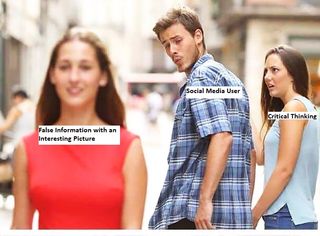Memes
The Menace of Memes
Memes infect the internet and your mind with contagious ideas.
Posted October 31, 2019 Reviewed by Matt Huston
A cute animal picture with a pithy saying can spread like wildfire across social media. Memes are contagious, infecting the internet and your mind. But those cute animal pictures can be dangerous.
Memes are ideas that infect minds. They develop by spreading from one person to another, like a transmittable disease. Or at least, that was the original idea proposed by Richard Dawkins in 1976. A meme is an idea that is easily transmitted from one mind to another through interaction – generally a conversation. Dawkins also noted that memes can change and evolve – becoming more fit so they are easier to pass along and be remembered. Memes evolve to become better at infecting your mind.
I’ve always thought of counting out rhymes as examples of memes. Maybe you learned “Eeny, meenie, miny, moe” as a child. If you did, it really was an idea that infected your mind. You caught it by playing with other kids (much like you catch a cold or the flu). You heard the rhyme, said it with other kids, and repeated it until the idea took up residence in your mind. Now, years later, your mind remains infected. And you have probably spread this infectious meme to others. This counting out rhyme has also evolved and morphed as it has spread from one person to another. Some people hold different versions, with different things caught by the toe and different endings. But the basic meme has spread throughout the minds of our common culture.
A counting-out rhyme isn’t particularly menacing. But memes have moved far beyond individual minds connecting in person. In essence, memes have evolved and found new habitats, the newest and largest of which is the internet.
Memes are menacing because they are particularly effective at getting people to adopt ideas. And internet memes are effective for several reasons.
First, adding a picture to a statement, research suggests, can make people more likely to believe the statement, even when the picture is completely unrelated to the idea. This is known as the truthiness effect (Newman, Garry, Bernstein, Kantner, & Lindsay, 2012). Something about adding a picture seems to make it easier to believe that something is true.

I’ve read a very nice statement about being stardust that was attributed to Einstein and placed with a picture of the physicist. But Einstein never made the statement. Or consider this Socrates meme. Again, a lovely quote attributed to a famous thinker. And there’s no evidence that Socrates ever said anything like that. These fake quotes attach one idea to a well-known person and give the quote more validity. Nonetheless, these memes remain out there and I’ve seen several similar fake quotes in my social media feed.
Which brings me to a second reason memes are effective – they are presented repeatedly as you scan social media. An attractive meme will get shared and reposted by many people. Even if it is a false statement, you may see the same meme multiple times. And repeating any statement, whether true or false, can make people more likely to believe the statement. This finding is the illusory truth effect (Hasher, Goldstein, & Toppino, 1977).

I think a third reason many memes are effective is that they get reused frequently. Take the “red dress meme” as an example. Undoubtedly, if you have a social media feed you’ve seen this basic meme multiple times. I’ve included a version that I created in this blog post. The basic idea is that a guy walking with one woman ignores her to stare at a different woman. People apply this meme to any set of ideas where you should be captivated by something important (critical thinking, in my example) but are distracted by something else (an interesting picture meme with a false idea, in my example).
If you already know the format of the argument, that can make it easier to process a new idea. The meme doesn’t care whether the idea is true or false. It just wants to spread from one mind to another.
But the most menacing aspect of memes is that they attack us when we are most vulnerable. I chose my version of the red dress meme somewhat thoughtfully. We all know we should be careful when exposed to information on the internet. We know there are fake posts, false information, and conspiracy theories. We should always be critical thinkers, especially when we dive into the internet. But when scanning through my social media feed, I’m not always engaged in critical thinking. I’m looking at pictures and posts of what my friends, family, and former students are doing. I’m happy when things go well. I’m concerned when they experience difficulties. I’m not critically evaluating their life experiences.
When I encounter a meme, I don’t always bother to check if the statement attached to the cute puppy photo is true. I see it and I scan onward. Then I see it again and again. I don’t realize how often I’ve seen it. But the idea is easier to process and may feel true.
Memes are menacing because they can infect our minds when we are likely to be vulnerable. Memes are also menacing because people are purposely using them to infect your mind with false information. So be careful when scanning your social media feeds. Beware of simple, attractive ideas with pictures. Be careful, or the memes will infect your mind.
References
Hasher, Goldstein, & Toppino, (1977). Frequency and the conference of referential validity. Journal of Verbal Learning and Verbal Behavior, 16, 107-112.
Newman, Garry, Bernstein, Kantner, & Lindsay (2012). Nonprobative photographs (or words) inflate truthiness. Psychonomic Bulletin and Review, 19, 969-974.


